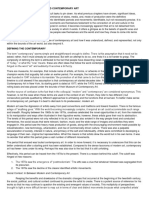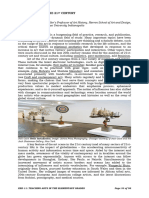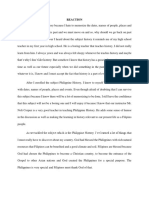The Future of Art
The Future of Art
Uploaded by
zian chenCopyright:
Available Formats
The Future of Art
The Future of Art
Uploaded by
zian chenOriginal Description:
Copyright
Available Formats
Share this document
Did you find this document useful?
Is this content inappropriate?
Copyright:
Available Formats
The Future of Art
The Future of Art
Uploaded by
zian chenCopyright:
Available Formats
The Future of Art
(Reported in occasion of the conference within the curated exhibition Truth, Beauty, Freedom & Money in K11 Art Space, Shanghai)
To begin with, I would like to share about my perspective of the exhibition title, which borrowed from media artist and researcher Michael Naimark. But before I learn it, I understand it in my own way, as that Money which guaranteed and generated by the neoliberal scandalous rhetoric Freedom is fiercely and overtly dragged our notion of Truth and Beauty of our age into another direction. Which I think is totally different compares to last century after the first public museum has established by French people. Theres a fundamental idea, which all Marxism theorists would never left behind, suggests the concurrency between infrastructure and superstructure, as we all know. When it comes to art, if we consider about its future, we starts from its infrastructure just as what Benjamin did when he prognoses photography in the beginning of modernist era. By infrastructure, I am considering both technical base that supported art as its media as well as its information in some respect, and also economic base, for we as homo economicus all rely on it. And Im here to talk about the second part and I see it as the main reason that its superstructure has thus shifted its ethos paradigmatically from criticality to creativity. Allow me to first remind you about the similar time frame as Zhenhuas concept, that it is now 2013, roughly 20 years since the right-wing bourgeois had overtaken the critical agency of institutional criticism, according to Hito Steyerl; and 15 years after Harald Szeemann, the first independent curator who participated as a juror in the controversial but influential institution called Chinese Contemporary Art Award, which was founded by his collector friend; 5 years ago, artist Anton Vidokle and curator Tirdad Zolghadr submitted themselves to prosecution, for they colluded with the bourgeoisie. As the timeline for art becomes almost completely an instrument of capitalist power, there are only 2 years remain as predicted by Maria Lind in 2005 on the occasion of and supported by the Frieze Art Fair in London. Contemporary art is currently undergoing an unprecedented structural transformation through an injection of economic vitality that dominates and molds the features of art: it is the period that we are encountering the most art institutions, systems of collection, the most abundance in exhibitions and artists as well as art schools and art students. In the past 20 years along the current of privatization, the featured exhibitions that took place in apartments
and the consular district of Beijing and in alternative spaces of Taipei have all retreated to galleries, museums, and biennials. During almost the same time, our notion of art also experienced an interesting shift. The ethos of art moved away from the position of resistance, which contributed by our modernist avant-garde predecessors. Artists become distributors of imaginations rather than a critical agent; their expression to the audiences through their art work that was once rebellion and interrogation in the content of the work gradually tilted to be kind of free drifting which is we found it poetic and contemplative. This does not represent that art no longer strive to resist and to be critical. Speaking of quantity alone, perhaps it has been more numerous than the previous 20 years. The difference be that the methodology and tactic that artists use is re-adjusted into a top-down procedure. For another, with regard to the scale of production, artists no longer solely rely on individual effort to complete the production of their works. Instead, they mobilize assistants, inter-personal relationships as well as interdisciplinary and cross institutional cooperation in so far as possessing the means to integrate mass media and fund raising. Through the development of division of labor, integrated by capital, todays artists possess a diversity of methodology, which is unprecedented in comparison to their predecessors. While artists are able to subvert the human sense perception in the most edgy ever way, if we can no longer use the term radical, it seems, the routes of criticality could only effectively works from above. Just as curator Charles Esche once said in an interview that many of the artists start telling stories again in order to explore meaning. Artist nowadays, devoted to restoring the strange web of space and time, namely, the privileged sign. Here comes a new breed of institution, where artists integrate people, events and objects which cross a range of space and time, through new media, traditional artistry even antiques with material in physical reach or by transnational allocation of resources giving art narrative material distinct from the past.
You might also like
- Arth Midterm Study NotesDocument12 pagesArth Midterm Study Notesaryana100% (2)
- Art in the After-Culture: Capitalist Crisis and Cultural StrategyFrom EverandArt in the After-Culture: Capitalist Crisis and Cultural StrategyNo ratings yet
- How to Do Things with Art: The Meaning of Art's PerformativityFrom EverandHow to Do Things with Art: The Meaning of Art's PerformativityRating: 4.5 out of 5 stars4.5/5 (2)
- How To Train Your Dragon Book 3: How To Speak Dragonese by Cressida CowellDocument14 pagesHow To Train Your Dragon Book 3: How To Speak Dragonese by Cressida CowellLittle, Brown Books for Young Readers43% (44)
- Jacques Ranciere - Art of The Possible: Fulvia Carnevale and John Kelsey in Conversation With Jacques RanciereDocument10 pagesJacques Ranciere - Art of The Possible: Fulvia Carnevale and John Kelsey in Conversation With Jacques RanciereposokNo ratings yet
- Hantelmann SocioPoliticsexhibitionDocument13 pagesHantelmann SocioPoliticsexhibitionValeriaTellezNiemeyerNo ratings yet
- Snare Etudes - IMEA Sets 1,2,3 Advace PDFDocument7 pagesSnare Etudes - IMEA Sets 1,2,3 Advace PDFpjaureguiNo ratings yet
- Cry, The Beloved CountryDocument36 pagesCry, The Beloved CountryMariela RomeroNo ratings yet
- Module 8 10 ArtDocument13 pagesModule 8 10 ArtcyrusjojieNo ratings yet
- ArtForum - Art of The Possible - Fulvia Carnevale and John Kelsey in Conversation With Jacques RanciereDocument8 pagesArtForum - Art of The Possible - Fulvia Carnevale and John Kelsey in Conversation With Jacques RancierehansimannNo ratings yet
- Modern and Contemporary ArtDocument5 pagesModern and Contemporary ArtMARLA JOY LUCERNANo ratings yet
- Contemporary Art Is The Art of Today, Produced in The Second Half of The 20th Century or in TheDocument8 pagesContemporary Art Is The Art of Today, Produced in The Second Half of The 20th Century or in TheCatrinah Raye VillarinNo ratings yet
- On Curating: Interviews with Ten International Curators: By Carolee TheaFrom EverandOn Curating: Interviews with Ten International Curators: By Carolee TheaRating: 3.5 out of 5 stars3.5/5 (3)
- Madlang JakeDocument4 pagesMadlang JakeCathy VillaramaNo ratings yet
- Mary Jane Jacob - An Unfashionable Audience - 50-59Document10 pagesMary Jane Jacob - An Unfashionable Audience - 50-59lilaNo ratings yet
- Week 13 Contemporary ArtDocument4 pagesWeek 13 Contemporary ArtJade CarbonNo ratings yet
- Cpar - Lesson 1-3Document50 pagesCpar - Lesson 1-3danielhandig.bragaisNo ratings yet
- 9129 9835 1 PBDocument74 pages9129 9835 1 PBrockinqueenfulNo ratings yet
- LESSON 9 - Modern and Contemporary ArtDocument4 pagesLESSON 9 - Modern and Contemporary ArtRuby Jane Durado0% (1)
- Art AppDocument17 pagesArt AppBeh Verly Co TorreonNo ratings yet
- TOTAL ABSTRACTION, Dorothee Richter, New Markets and Forms of Capital in ArtDocument15 pagesTOTAL ABSTRACTION, Dorothee Richter, New Markets and Forms of Capital in ArtArnaud JammetNo ratings yet
- Nicholas Bourriaud - PostproductionDocument45 pagesNicholas Bourriaud - PostproductionElla Lewis-WilliamsNo ratings yet
- Will Bradley Art and Social Change IntroductionDocument12 pagesWill Bradley Art and Social Change IntroductionLuka JurićNo ratings yet
- Contemporary Art and The Not-Now: Branislav DimitrijevićDocument8 pagesContemporary Art and The Not-Now: Branislav DimitrijevićAleksandar BoškovićNo ratings yet
- Art and Activism Iki Yonlu Arzu Brian HoDocument5 pagesArt and Activism Iki Yonlu Arzu Brian HozehirilepanzehirNo ratings yet
- New Institutional IsmDocument11 pagesNew Institutional Ismjose_guisado0% (1)
- Cronk - The Pseudo-Autonomy of ArtDocument2 pagesCronk - The Pseudo-Autonomy of ArtAudrey HernandezNo ratings yet
- What Was Contemporary Art?: Preamble. Over The Past Decade Critics Within Various Disciplines HaveDocument24 pagesWhat Was Contemporary Art?: Preamble. Over The Past Decade Critics Within Various Disciplines HaveGuy Blissett AmadoNo ratings yet
- Lesson 9Document3 pagesLesson 9swanvenusianNo ratings yet
- Zsuzsa Laszlo How ToDocument10 pagesZsuzsa Laszlo How ToZsuzsa LaszloNo ratings yet
- Lesson: Caught in Between: Modern and Contemporary ArtDocument14 pagesLesson: Caught in Between: Modern and Contemporary Artjessica navajaNo ratings yet
- Art of 21st CenturyDocument7 pagesArt of 21st CenturyAnamika ShabnamNo ratings yet
- T3W5 - Arts Lecture Package - For StudentsDocument4 pagesT3W5 - Arts Lecture Package - For StudentsHanesh sureshkumarNo ratings yet
- Art 2ND YrDocument13 pagesArt 2ND YrGabrielle VaporNo ratings yet
- Art Appreciation Notes UNIT - 1Document13 pagesArt Appreciation Notes UNIT - 1francy sharonNo ratings yet
- New Institutional IsmDocument12 pagesNew Institutional Ismtemporarysite_orgNo ratings yet
- Ranciere Jacques Interview With Fulvia Carnevale and John KelseyDocument20 pagesRanciere Jacques Interview With Fulvia Carnevale and John KelseyDavidNo ratings yet
- Claire Bishop IntroductionDocument2 pagesClaire Bishop IntroductionAlessandroValerioZamoraNo ratings yet
- Contemporary Art PracticesDocument2 pagesContemporary Art PracticesRodrick Sonajo RamosNo ratings yet
- Arts App Activity 7Document9 pagesArts App Activity 7Dana BarrosaNo ratings yet
- Art in America 99%Document2 pagesArt in America 99%Erin Marie SicklerNo ratings yet
- Being CuratedDocument15 pagesBeing CuratedJody TurnerNo ratings yet
- SpeculationFrom EverandSpeculationMarina VishmidtRating: 4 out of 5 stars4/5 (2)
- The Art, Artist and ArtisanDocument18 pagesThe Art, Artist and ArtisanlaNo ratings yet
- Artapp AdditionalDocument7 pagesArtapp AdditionalJeralyn Gozon ElarmoNo ratings yet
- Contemporary Art - WikipediaDocument6 pagesContemporary Art - WikipediaAThaddeusAntonioNo ratings yet
- Art in The 21st CenturyDocument3 pagesArt in The 21st CenturyLhyn Liam-LameraNo ratings yet
- Bourriaud Nicolas - PostproductionDocument47 pagesBourriaud Nicolas - PostproductionEd ThompsonNo ratings yet
- Discussion Notes - LESSON 4 5Document5 pagesDiscussion Notes - LESSON 4 5micahreazon43No ratings yet
- Goedhuis INK - The Art of China at The SAATCHI GALLERY 5-18-2012 1Document102 pagesGoedhuis INK - The Art of China at The SAATCHI GALLERY 5-18-2012 1DanielMarija100% (4)
- John Rajchman O Pensamento Na Arte Contemporânea - EnglishDocument8 pagesJohn Rajchman O Pensamento Na Arte Contemporânea - EnglishJúlia LeeNo ratings yet
- Reading No. 2Document3 pagesReading No. 2Eloisa Espino GabonNo ratings yet
- Elements and Principles of Contemporary Arts 1. AppropriationDocument9 pagesElements and Principles of Contemporary Arts 1. Appropriationhanintalib21No ratings yet
- Art in History, 600 BC - 2000 AD: Ideas in ProfileFrom EverandArt in History, 600 BC - 2000 AD: Ideas in ProfileRating: 4 out of 5 stars4/5 (4)
- Fusing Lab and Gallery: Device Art in Japan and International Nano ArtFrom EverandFusing Lab and Gallery: Device Art in Japan and International Nano ArtNo ratings yet
- Artificial Hells: Participatory Art and the Politics of SpectatorshipFrom EverandArtificial Hells: Participatory Art and the Politics of SpectatorshipRating: 4.5 out of 5 stars4.5/5 (10)
- The New Renaissance: How Art, Culture, and Tech Are Shaping Tomorrow’s WorldFrom EverandThe New Renaissance: How Art, Culture, and Tech Are Shaping Tomorrow’s WorldNo ratings yet
- Learning Pack: PRE A1 STARTERS - Unit 2: You and I (Video 3)Document12 pagesLearning Pack: PRE A1 STARTERS - Unit 2: You and I (Video 3)Yuri HeahNo ratings yet
- Jupiter 80 PaDocument40 pagesJupiter 80 PaFabio CurielNo ratings yet
- 1Document10 pages1Arijit SenNo ratings yet
- House On Man Go StreetDocument3 pagesHouse On Man Go StreetCliff StaeblerNo ratings yet
- Jang Will Goingto Presentc ExDocument8 pagesJang Will Goingto Presentc ExDaniel CubillosNo ratings yet
- All About BambooDocument24 pagesAll About BambooSENTHIL KUMAR100% (1)
- 1UR0 1H Que 20201103Document16 pages1UR0 1H Que 20201103Muhammad SaleemNo ratings yet
- Language II Module 2 Adjectives and AdverbsDocument25 pagesLanguage II Module 2 Adjectives and AdverbsCarla Arredondo MagnereNo ratings yet
- Foam Core Pipes and Fittings - Trubore PipesDocument2 pagesFoam Core Pipes and Fittings - Trubore PipesElprointernational SchoolNo ratings yet
- University of Cambridge International Examinations General Certificate of Education Ordinary LevelDocument4 pagesUniversity of Cambridge International Examinations General Certificate of Education Ordinary LevelShafiq Mannan100% (1)
- Newtons Date For The CrucifixionDocument5 pagesNewtons Date For The CrucifixionAbanoubNo ratings yet
- Newsletter 1new3 6 14Document1 pageNewsletter 1new3 6 14mrvaughanNo ratings yet
- List of Registered Suppliers Per Category As of December 2018Document6 pagesList of Registered Suppliers Per Category As of December 2018Emman100% (2)
- Reaction PaperDocument3 pagesReaction PaperRosa Linda Murao Peralta100% (2)
- Think l2 Video Ep4Document1 pageThink l2 Video Ep4GinanaNo ratings yet
- Claude Levi-Strauss and StructuralismDocument3 pagesClaude Levi-Strauss and StructuralismPraveen NNo ratings yet
- 11AGDocument5 pages11AGalejandraNo ratings yet
- Paris Guide by FlashbookingDocument10 pagesParis Guide by FlashbookingsanazhNo ratings yet
- Literary Devices Used To ForeshadowDocument3 pagesLiterary Devices Used To ForeshadowtaypaigehNo ratings yet
- Jitante Stotram v4 PDFDocument71 pagesJitante Stotram v4 PDFRamadevaNo ratings yet
- Personal DevotionsDocument2 pagesPersonal DevotionsLucky Pimentel CataluñaNo ratings yet
- 36rh, 37rh, 46rh, 46re, 47rh, 47re, 48reDocument12 pages36rh, 37rh, 46rh, 46re, 47rh, 47re, 48remyszkinson86% (7)
- Hansel and GretelDocument3 pagesHansel and Gretelapi-502145517No ratings yet
- Usbnsmp2018ing999 PDFDocument7 pagesUsbnsmp2018ing999 PDFwulannNo ratings yet
- Figures of SpeechDocument2 pagesFigures of Speechmar cris velascoNo ratings yet
- Department of Education Division of Batangas Bilaran National High SchoolDocument3 pagesDepartment of Education Division of Batangas Bilaran National High SchoolMary Kristene Celitona DumanNo ratings yet
- Ousterhout Byzantine - Architecture - A - Moving - Target PDFDocument18 pagesOusterhout Byzantine - Architecture - A - Moving - Target PDFAndrei DumitrescuNo ratings yet

























































































